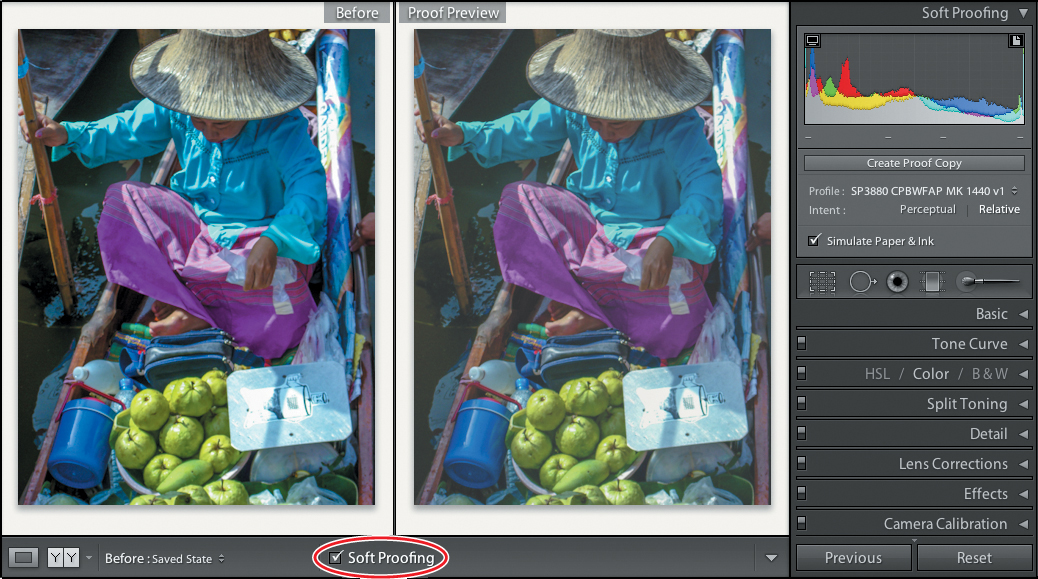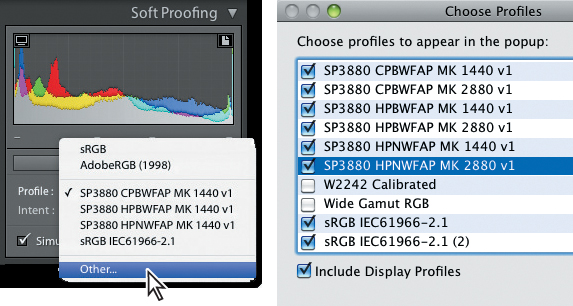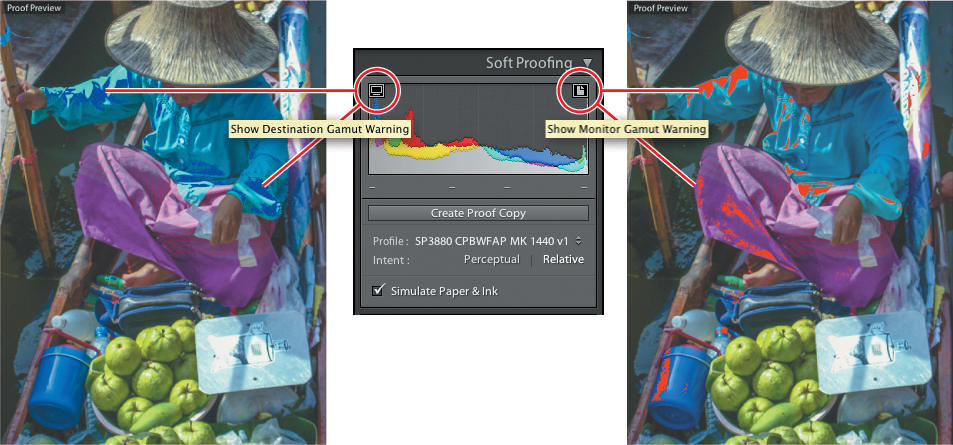9. Printing Images
Lesson overview
The Lightroom Print module offers all the tools you’ll need to quickly prepare any selection of images from your library for printing.
You can print a single photo, repeat one image at different sizes on the same sheet, or create an attractive layout for multiple images. Add borders, text, and graphics, and then adjust print resolution, sharpening, paper type, and color management with just a few clicks.
In this lesson, you’ll explore the Print module as you become familiar with the steps in the printing workflow:
• Choosing a print template
• Customizing the layout and output settings
• Creating a Custom Package print layout
• Adding an identity plate, borders and a background color
• Captioning photos with information from their metadata
• Saving a custom print template
• Specifying print settings and printer driver options
• Choosing appropriate color management options
• Saving a print job as an output collection
You’ll probably need between one and two hours to complete this lesson.
Whether you need to print a contact sheet or a fine art mat, Lightroom makes it easy to achieve professional results with a choice of highly customizable layout templates.
Getting started
This lesson assumes that you are already familiar with the Lightroom workspace and with moving between the different modules. If you find that you need more background information, refer to Lightroom Help, or review the previous lessons.
Before you begin, make sure that you have correctly copied the Lessons folder from the CD in the back of this book onto your computer’s hard disk as detailed in “Copying the Classroom in a Book files” on page 2, and created the LR4CIB Library Catalog file to manage the lesson files as described in “Creating a catalog file for working with this book” on page 3.
1. Start Lightroom.
2. In the Adobe Photoshop Lightroom - Select Catalog dialog box, make sure the file LR4CIB Library Catalog.lrcat is selected under Select A Recent Catalog To Open, and then click Open.

3. Lightroom will open in the screen mode and workspace module that were active when you last quit. If necessary, switch to the Library module by clicking Library in the Module Picker at the top of the workspace.

The first time you enter any of the Lightroom modules, you’ll see module tips that will help you get started by identifying the components of the Lightroom workspace and stepping you through the workflow. Dismiss the tips by clicking the Close button. To reactivate the tips for any module, choose [Module name] Tips from the Help menu.
Importing images into the library
The first step is to import the images for this lesson into the Lightroom library.
1. In the Library module, click the Import button below the left panel group.
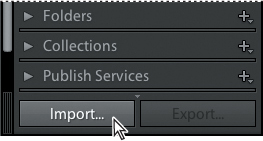
2. If the Import dialog box appears in compact mode, click the Show More Options button at the lower left to expand it.
3. Under Source at the left of the Import dialog box, navigate to and select the Lesson 9 folder (inside the LR4CIB > Lessons folder). Make sure that all six images in the Lesson 9 folder are checked for import.
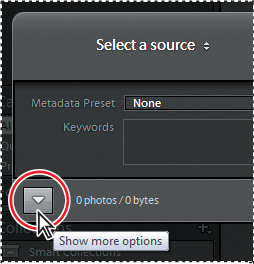
4. In the import options picker above the thumbnail previews, select Add so that the imported photos will be added to your catalog without being moved or copied. Under File Handling at the right of the Import dialog box, choose Minimal from the Render Previews menu and ensure that the Don’t Import Suspected Duplicates option is activated. Under Apply During Import, choose None from both the Develop Settings menu and the Metadata menu, and type Lesson 9, Portraits in the Keywords text box. Make sure that your import is set up as shown in the illustration below, and then click Import.
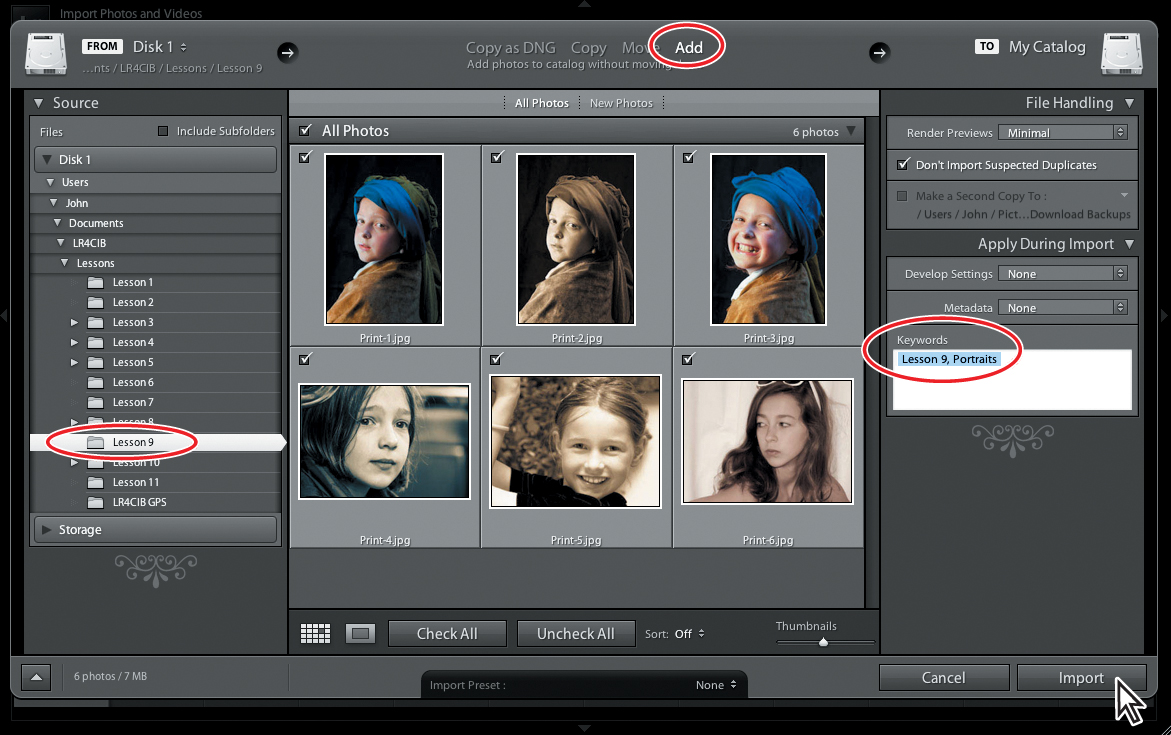
The six images from the Lesson 9 folder appear in both the Library module Grid view and the Filmstrip across the bottom of the Lightroom workspace.
5. You won’t be able to rearrange the images for your print job as long as Previous Import is selected as the image source in the Catalog panel. In the Folders panel, click the Lesson 9 folder to change the image source. In the Toolbar, set the Sort order to File Name; then, click Print in the Module Picker at the top of the workspace to switch to the Print Module.

About the Lightroom Print module
In the Print module you’ll find tools and controls for each step in the printing workflow. Change the order of your photos, choose a print template and refine the layout, add borders, text, and graphics, and then adjust the output settings; everything you need to produce professional-looking prints is at your fingertips.
The left panel group contains the Preview, Template Browser, and Collections panels. Move the pointer over the list in the Template Browser to see a thumbnail preview of each layout template displayed in the Preview panel. When you choose a new template from the list, the Print Editor view—at center-stage in the workspace—is updated to show how the selected photos look in the new layout.
You can quickly select and rearrange the photos for your print job in the Filmstrip, where the source menu provides easy access to the images in your library, listing your favorites and recently used source folders and collections.
You’ll use the controls in the right panel group to customize your layout template and to specify output settings.
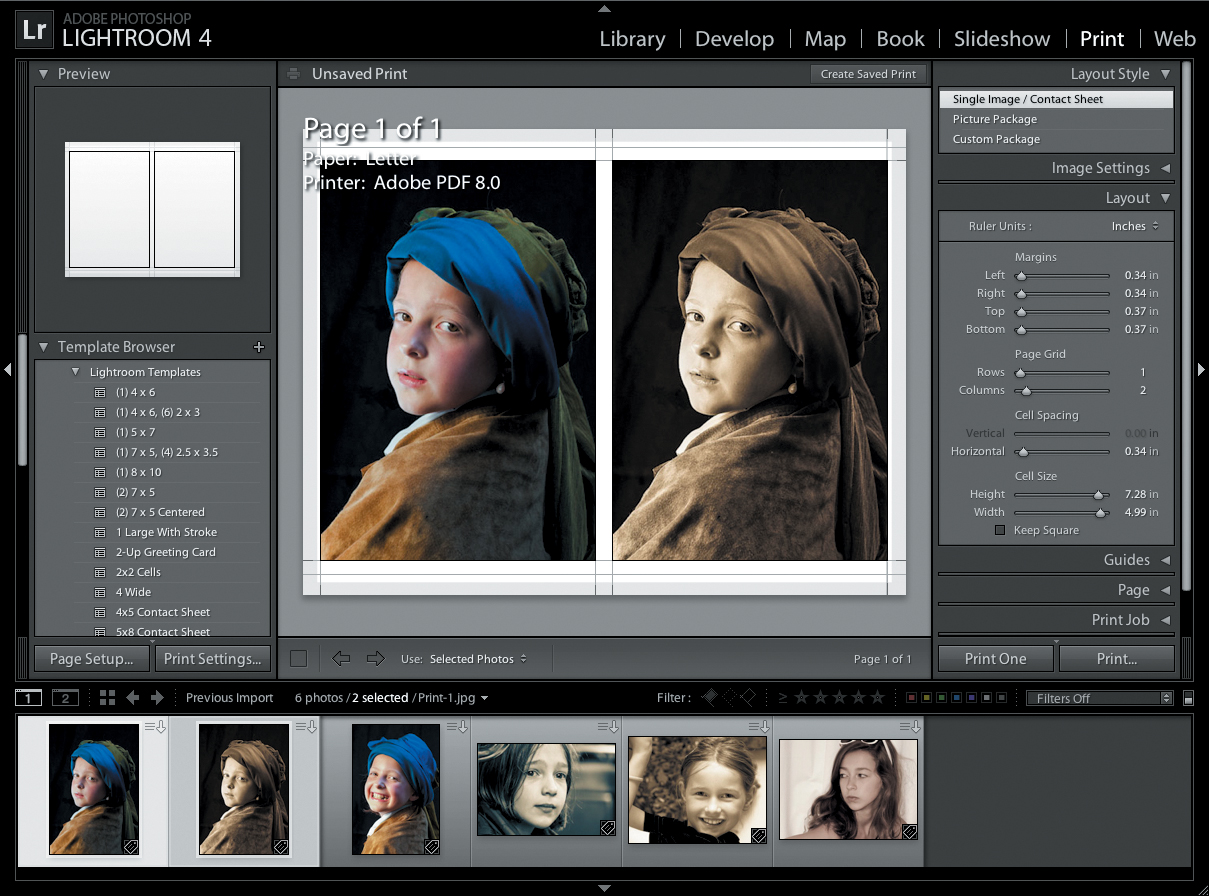
The Template Browser contains templates of three distinct types: Single Image / Contact Sheet layouts, Picture Package layouts, and Custom Package layouts.
Four of the first fifteen preset Lightroom templates in the menu are Picture Package layouts, which repeat a single image at a variety of sizes on the same page. The other eleven are Single Image / Contact Sheet layouts, which can be used to print multiple photos at the same size on a single sheet. Single Image / Contact Sheet layouts are based on an adjustable grid of image cells. They range from contact sheets with many cells to single-cell layouts such as the Fine Art Mat and Maximize Size templates. The Custom layout templates further down the menu enable you to print multiple images at any size on the same page. All of the templates can be customized; you can save your modified layouts as user-defined templates, which will be listed in the Template Browser.
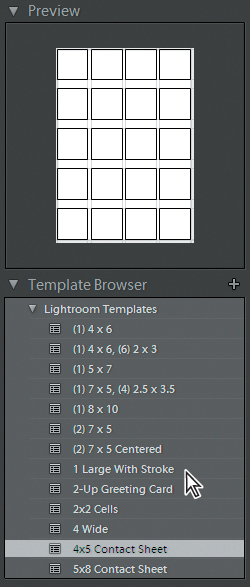
Once you’ve chosen a layout from the Template Browser, the Layout Style panel at the top of the right panel group indicates which type of template you’re working with. The suite of panels you see below the Layout Style panel will vary slightly, depending on which type of template you have chosen.
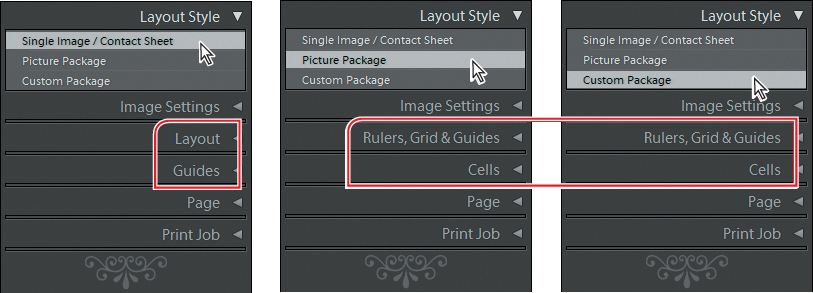
The controls in the Image Settings panel enable you to add photo borders and to specify the way your pictures are fitted to their image cells.
For a Single Image / Contact Sheet template, you can use the Layout panel to adjust margins, cell size and spacing, and to change the number of rows and columns that make up the grid. For a Picture Package or Custom package template, you’ll modify your layout with the Rulers, Grid & Guides panel and the Cells panel. Use the Guides panel to show or hide a selection of layout guides. The Page panel has controls for watermarking your images and adding text, graphics, or a background color to your print layout. In the Print Job panel you can set the print resolution, print sharpening, paper type, and color management options.
About layout styles and print templates
The Template Browser offers a wide choice of preset Lightroom print templates that differ not only in basic layout but may also include a variety of design features such as borders and overlaid text or graphics.
Templates may also differ in their output settings: the print resolution setting for a contact sheet will be lower than the resolution set for a template designed for producing finished prints.
You can save time and effort setting up your print job by selecting the print template that most closely suits your purpose. In this exercise you’ll be introduced to the different types of templates and use the panels in the right panel group to examine the characteristics of each layout.
1. In the left panel group, make sure that the Preview and Template Browser panels are expanded. If necessary, drag the top border of the Filmstrip down so that you can see as many of the templates in the Template Browser as possible. In the right panel group, expand the Layout Style panel and collapse the others.
2. Choose Edit > Select None, and then select just one of the images in the Filmstrip. The Print Editor view at the center of the workspace is updated to display the selected photo in the current layout.
3. If necessary, expand the Lightroom Templates folder inside the Template Browser panel. Move the pointer slowly over the list of preset templates to see a preview of each layout in the Preview panel.
4. Click the second template in the Template Browser: “(1) 4 × 6, (6) 2 × 3.” The new template is applied to the image in the Print Editor view. Scroll up in the right panel group, if necessary, and inspect the Layout Style panel. You’ll see that the Layout Style panel indicates that this template is a Picture Package layout. In the Template Browser, click the sixth Lightroom template “(2) 7 × 5.” The Layout Style panel indicates that this is also a Picture Package layout.
5. Now choose the ninth preset template in the Template Browser: “2-Up Greeting Card.” The Layout Style panel indicates that the template “2-Up Greeting Card” is a Single Image / Contact Sheet layout, and the Print Editor view at the center of the workspace displays the new template.
6. In the Layout Style panel, click Picture Package. The Print Editor is updated to display the last selected Picture Package layout: “(2) 7 × 5.” Click Single Image / Contact Sheet in the Layout Style panel and the Print Editor view returns to the last selected Single Image / Contact Sheet layout: “2-Up Greeting Card.”
You’ll notice that different control panels become available in the right panel group as you move between the Single Image / Contact Sheet and Picture Package layout styles. Panels common to both layout styles may differ in content.
7. In the right panel group, expand the Image Settings panel. In the Layout Style panel, click Picture Package and expand the Image Settings panel again. Toggle between the Picture Package and Single Image / Contact Sheet layouts and notice how the options available in the Image Settings panel change.
You can see that the selected photo fits to the image cell differently for each of these templates. In the Picture Package layout “(2) 7 × 5,” the Zoom To Fill option is activated in the Image Settings panel so that the photo is zoomed and cropped to fill the image cell. In the Single Image / Contact Sheet “2-Up Greeting Card,” the Zoom to Fill option is disabled and the photo is not cropped. Take a moment to examine the other differences in the Image Settings panel.
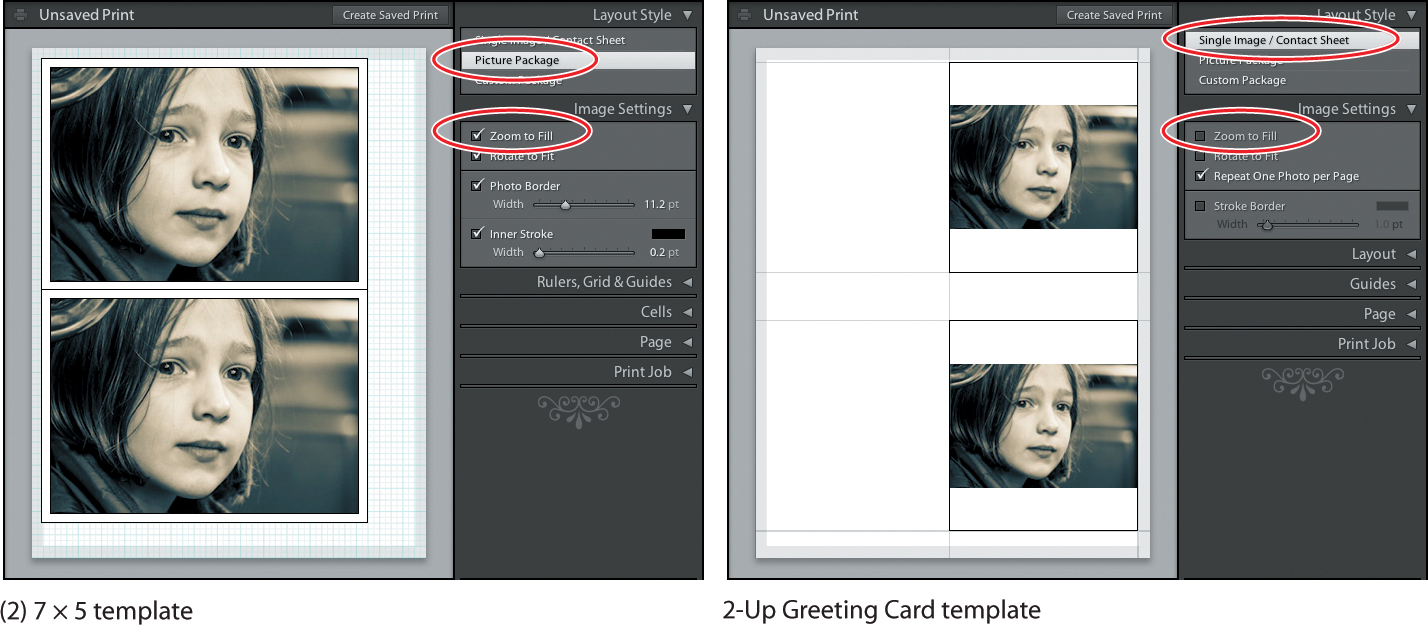
8. Select the Single Image / Contact Sheet layout style. Look at the page count at the right of the Toolbar below the Print Editor view: it reads “Page 1 of 1.” Press Ctrl+A / Command+A or choose Edit > Select All to select all six images in the Filmstrip. The page count in the Toolbar now reads “Page x of 6.” The template “2-Up Greeting Card” is now applied to all six photos, resulting in a print job of six pages. Use the navigation buttons at the left the Toolbar to move between the pages and see the layout applied to each image in turn.

You can also navigate your multi-page print document by using the Home, End, Page Up, Page Down, and left and right arrow keys on your keyboard, or choosing from the navigation commands in the Print menu.
9. For the last step in this exercise, collapse the Image Settings panel and expand the Print Job panel. You’ll notice that in the Print Job panel, the Print Resolution for the “2-Up Greeting Card” template is set to 240 ppi. Select the template “4×5 Contact Sheet” in the Template Browser. The Print Resolution option in the Print Job panel is disabled and the Draft Mode Printing option is activated.
Selecting a print template
Now that you’ve explored the Template Browser, it’s time to choose the template that you’ll customize in the next exercise.
1. In the Template Browser, click the template “4 Wide.” Later in this lesson you’ll customize your identity plate, but for now, uncheck the Identity Plate option in the Page panel to hide the default design.
2. Choose Edit > Select None. In the Filmstrip, select the images Print-4.jpg, Print-5.jpg, and Print-6.jpg. The images will be arranged in the template in the same order in which they appear in the Filmstrip. Drag the images inside their grid cells to reposition them as shown in the illustration below.
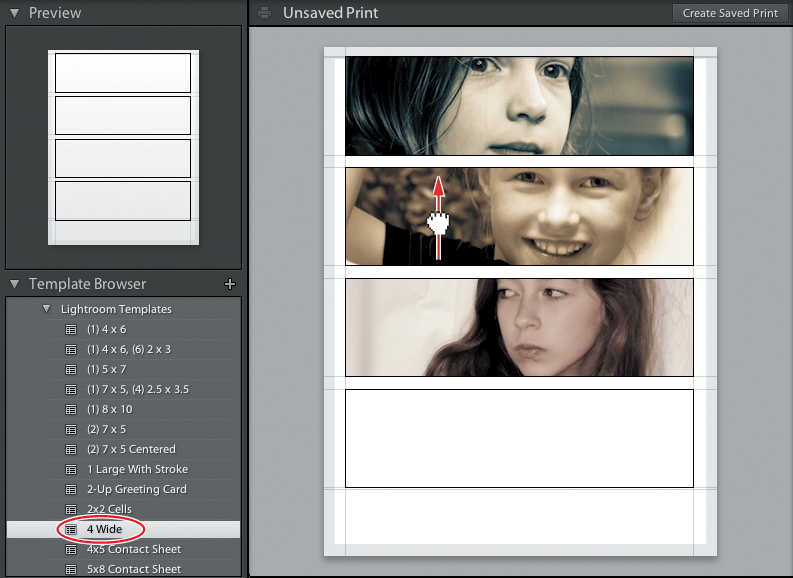
By default, each photo will be centered in its own image cell. To expose a different portion of an image that is cropped by the boundaries of its cell, simply drag the photo to reposition it within its image cell.
Specifying the printer and paper size
Before you customize the template, you’ll need to specify the paper size and page orientation for your print job. Doing this now may save you the time and effort of readjusting the layout later.
Lightroom automatically scales your photos in the print layout template to fit the paper size you have specified. In the Print Setup / Page Setup dialog box, leave the scale setting at the default 100% and let Lightroom fit the template to the page—that way, what you see in the Print Editor view will be what you’ll get from your printer.
1. Choose File > Page Setup.
2. In the Print Setup / Page Setup dialog box, choose the desired printer from the Name / Format For menu. From the Paper Size menu, choose Letter (Windows) / US Letter > US Letter (Mac OS). Under Orientation, choose portrait format (vertical), and then click OK.
Customizing print templates
Having established the overall layout of your print job, you can use the controls in the Layout panel to fine-tune the template so that the images fit better to the page.
Changing the number of cells
For the purposes of this exercise, we need only three of the four preset image cells.
1. If necessary, expand the Layout panel in the right panel group. Under Page Grid, drag the Rows slider to the left or type 3 in the text box to the right of the slider.
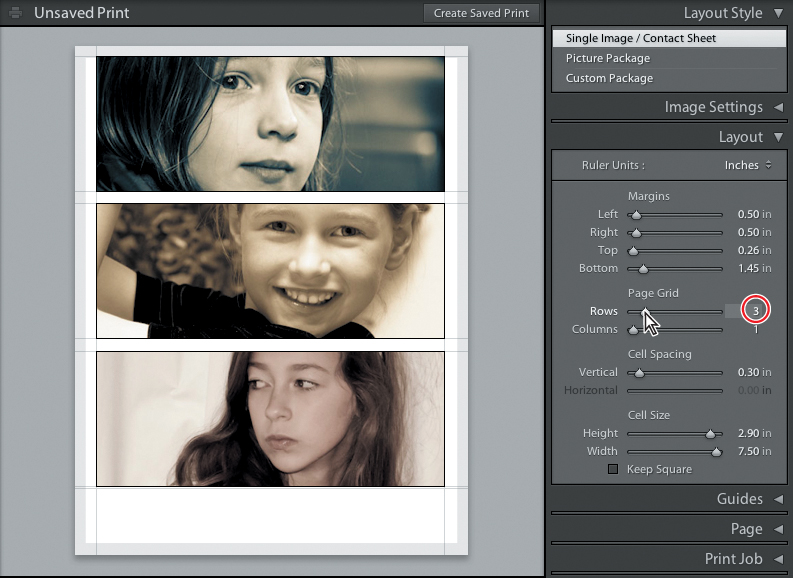
2. Experiment with the Margins, Cell Spacing, and Cell Size sliders—making sure to undo (Ctrl+Z / Command+Z) after each change. Activate the Keep Square option below the Cell Size sliders. The Cell Width and Cell Height sliders are locked together at the same value. Disable the Keep Square option.
3. The black lines you might see around the photos are merely guides indicating the image cell boundaries; they will not appear on your printed page. These guides are helpful while you’re adjusting the cell size and spacing but they’ll be distracting when you add printable borders to your layout in the next exercise. If necessary, expand the Guides panel below the Layout panel and disable the Image Cells option; then collapse the Layout and Guides panels.
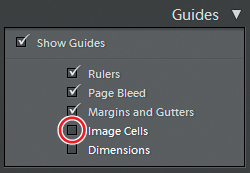
Rearranging the photos in a print layout
Lightroom places your photos in the cells of a multiple-image print layout in the order in which they appear in the Filmstrip (and the Library module Grid view).
If your image source is a Collection, or a folder without subfolders nested inside it, you can change the placement of your images in the print job by simply dragging their thumbnails to new positions in the Filmstrip. Rearranging photos in this way is not possible if either the All Photographs folder or Previous Import folder is the selected image source.
1. In the header bar of the Filmstrip, the Lesson 9 folder is listed as the source of the images displayed. Click the white triangle to the right of the image source information in the header bar of the Filmstrip to see the options available in the source menu.

If you enter the Print module with the Previous Import folder selected as the image source, making it impossible to reorder the photos for your print job, you can choose from recently opened folders and collections in the Filmstrip source menu.
2. Choose Edit > Select None, or press Ctrl+D / Command+D on your keyboard; then, drag the thumbnails in the Filmstrip to reverse the order of the last three photos, Print-4, Print-5, and Print-6.
3. Ctrl-click / Command-click to group-select the three reordered photos in the Filmstrip.

The three photos are rearranged in your modified layout template to reflect the new sorting order in the Filmstrip.
For a Picture Package layout, which repeats a single photo at various sizes on the same page, a new page is added to the print job for each selected photo; reordering the photos in the Filmstrip will affect only the page order.
Creating stroke and photo borders
For our Single Image / Contact Sheet layout, the Image Settings panel offers options that affect the way your photos are placed in the image cells, and a control for adding borders. In this exercise you’ll add a stroke border around each of the three images and adjust the width of the stroke.
1. Expand the Image Settings panel. For the 4 Wide template, the Zoom To Fill option is activated. This means that our photos are cropped in height to fit the proportions of the image cells.

2. Click the checkbox to activate the Stroke Border option, and then drag the Width slider to the right or type 2.0 in the text box to the right of the slider. For your reference, 72 points (pt) are one inch.

You can change the color of the border by clicking the Stroke Border color swatch and choosing a color from the Color Picker.
3. In the Layout Type panel, click Picture Package. In the Rulers, Grid & Guides panel, activate the Image cells option to see the borders of the cells. For a Picture Package template, the Image Settings panel offers two controls for borders. An Inner Stroke border is the Picture Package equivalent of a Stroke Border. The Photo Border control lets you set the width of a blank frame between the edge of each photo and the boundary of its image cell.

4. Experiment with the Inner Stroke and Photo Border settings.
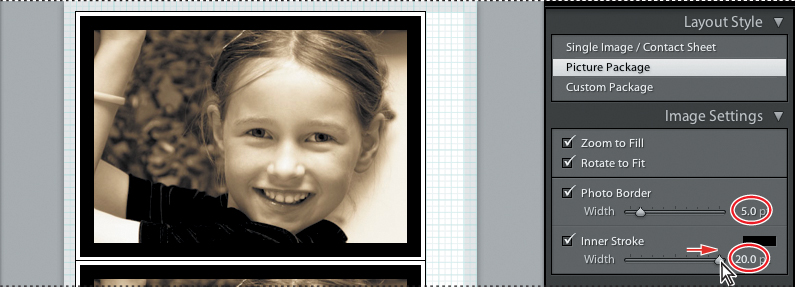
5. Disable the Image Cell guides. In the Layout Type panel, click Single Image / Contact Sheet to return to your modified 4 Wide template.
Customizing your identity plate
In the Page panel you’ll find controls for adding an identity plate, crop marks, page numbers, and text information from your photos’ metadata to your layout. To begin with, you’ll edit the identity plate to suit your layout.
1. Expand the Page panel; then click the checkbox to activate the Identity Plate option. The illustration at the right shows a preview of the default Identity Plate on Windows; on Mac OS, the default design will feature your user name. Click the triangle in the lower right corner of the identity plate preview pane and choose Edit from the menu.

2. In the Identity Plate Editor dialog box, activate the Use A Styled Text Identity Plate option. Choose Arial, Regular, and 36 point from the font menus. To change the text color, swipe over the text in the text box to select it, and then click the color swatch to the right of the font size menu; we chose a slightly darker gray than the default. Swipe to select the text again, if necessary, and type Manneken Photography (or a name of your own choice); then click OK.
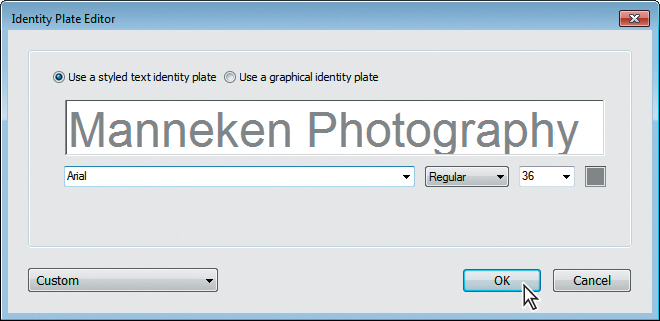
If your text is too long to be fully visible in the text box, either resize the dialog box or reduce the font size until you’ve finished editing.
3. In the Page panel, drag the Scale slider to the right so that the identity plate text is the same width as the image. You can also scale the identity plate by clicking it in the Print Editor view and dragging the handles of its bounding box.

By default the identity plate will be oriented horizontally. This setting (0°) is indicated at the top right of the Identity Plate pane in the Page panel. To re-orient your identity plate on the page, click on the 0° indicator and choose 90°, 180°, or −90° from the menu. To move your identity plate, simply drag it in the Print Editor view.
4. Now you’ll change the color of the identity plate. Click the Override Color checkbox to set the color of the identity plate for this layout only—without affecting the defined color settings for the identity plate.
5. Click the Override Color swatch to open the Color Picker. Set the RGB values: R: 45%, G: 25%, B: 20%, and then close the Color Picker. The color of the text identity plate now reflects the tones of the photo at the top of the page.
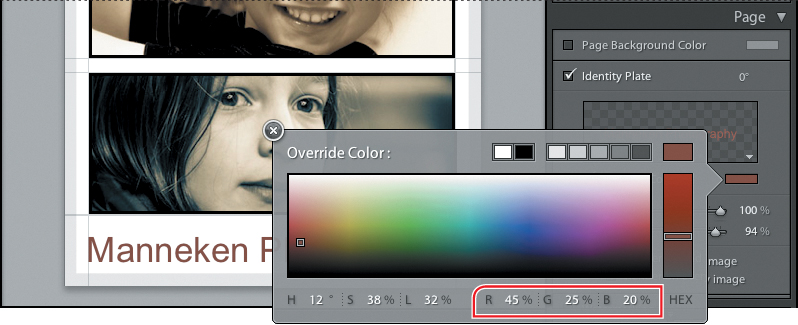
If you see a hexadecimal value displayed in the lower right corner of the Color Picker rather than RGB values, click RGB below the color slider.
6. In the Identity Plate pane, use the Opacity slider or type 75 in the text box beside it to set an opacity value of 75% for the identity plate. This feature can be particularly effective if you wish to position your identity plate over an image.

Printing captions and metadata information
In this exercise, you will add a caption and metadata information—in this case, titles for the images—to your print layout using the Page panel and the Text Template Editor.
1. At the bottom of the the Page panel, click the checkbox to activate the Photo Info overlay option; then choose Edit from the menu to the right. Most of the other options in the Photo Info menu are drawn from the images’ existing metadata.

The Text Template Editor enables you to combine custom text with the metadata embedded in your image files, and then save your edited template as a new preset, making it easy to add the same items of text information to future print jobs.
The names of the subjects of our lesson photos have been entered in the Title field of the images’ metadata; you’ll base your text captions on these photo titles.
You’ll find more detailed information on the Text Template Editor in the section “Using the Text Template Editor” in Lesson 8.
2. Choose Title from the Preset menu at the top of the Text Template Editor dialog box.
3. Click to place the insertion cursor just before the Title token in the Example text box. Type Portraits:, making sure to add the colon; then, type a space between your text and the token.
4. Click to place the cursor after the Title token in the Example box. Type a comma and a space; then choose Date (Month) from the second Numbering menu. If the Date (Month) token does not appear in the Example box, click the Insert button to the right of the Date menu.

5. Add a space after the Date (Month) token; then, choose Date (YYYY) from the second Numbering menu and click the Insert button if necessary.
6. Click Done to close the Text Template Editor dialog box. The images in the Print Editor view are now titled and dated.

7. Click the triangle beside the Font Size menu at the bottom of the Page panel and choose 12 pt; then collapse the Page panel.
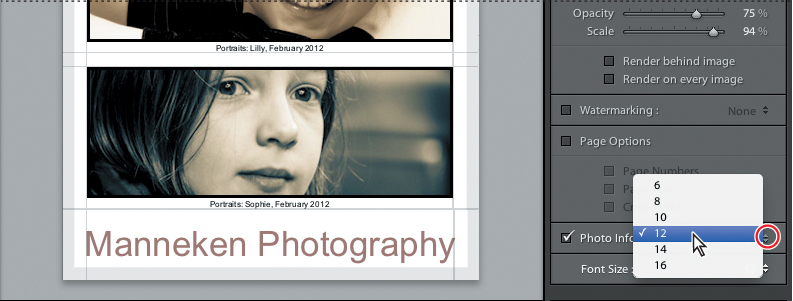
Saving your customized print template
Having started with a preset print template, you’ve created your own page design by modifying the layout and adding borders, an identity plate, and caption text to the images. You can now save your customized layout for future use.
1. Click the Create New Preset button (+) in the header of the Template Browser panel header, or choose Print > New Template.

2. In the New Template dialog box, type My Wide Triptych in the Template Name text box. By default, new templates are saved to the User Templates folder. For this exercise, accept the default User Templates as the destination folder and click Create.

3. Your saved template appears in the User Templates folder in the Template Browser panel where you can access it quickly for use with a new set of images. With your new template selected in the Template Browser, select the first three images in the Filmstrip, Print-1.jpg, Print-2.jpg, and Print-3.jpg.

Creating a Custom Package print layout
Every Single Image / Contact Sheet template is based on a grid of image cells that are all the same size. If you want a more free-form layout, or you prefer to create your own page layout from scratch, without using any of the preset templates as a starting point, you can use the Custom Package option in the Layout Style panel.
If you’d prefer to work without using a template, start by clicking Custom Package in the Layout Style panel; then, click Clear Layout in the Cells panel and drag photos from the Filmstrip directly onto the page preview.
1. Choose Edit > Select None, or press Ctrl+D / Command+D on your keyboard. In the Template Browser, scroll down the list of Lightroom templates, if necessary, and select the Custom Overlap × 3 layout. Click the Page Setup button below the left panels and make sure that the paper size is set to A4.

2. In The Rulers, Grid & Guides panel, click the double triangle beside the Grid Snap setting and choose Grid from the menu. This will make it easier to arrange the images in your print layout. Activate the Show Guides option, if necessary, and then click the checkboxes to show only the Page Bleed and Page Grid guides.

3. Click to select the central image cell in the Print Editor view, and then right-click / Control-click inside the selected cell. Note the options available in the context menu.
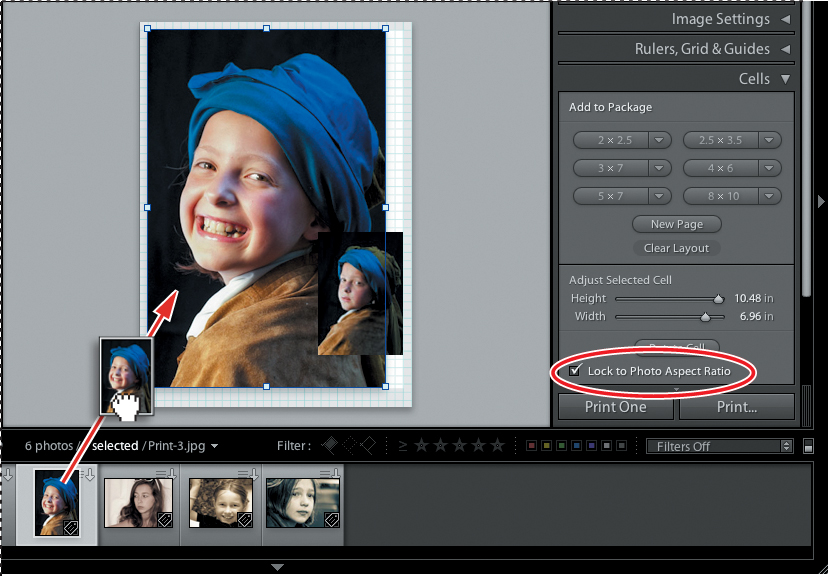
In a Custom Package images can be arranged so that they overlap. The first four commands in the context menu for a Custom Package image cell enable you to move an image backwards or forwards in the stacking order.
4. For now, choose Delete Cell from the context menu; then, delete either of the small cells.
5. Activate the Lock To Photo Aspect Ratio option in the Cells panel. Drag the image Print-1.jpg from the Filmstrip into the smaller image cell; then, drag the photo Print_3.jpg into the larger cell.
6. Select the smaller cell and use the Width slider in the Cells panel, or type in the text box, to set the width of the cell to 3 inches, and then press Enter / Return. Set the width of the larger image cell to 6.25 inches. Keep the large cell selected.
To reposition a photo inside its image cell, hold down the Ctrl / Command key as you drag the image.
7. Disable the Lock To Photo Aspect Ratio option, and then drag the handle at the top of the large cell’s bounding box downwards, or use the controls in the Cells panel to set the Height to 5.05 inches. With the Lock To Photo Aspect Ratio option disabled, the image is cropped to fill the resized cell.
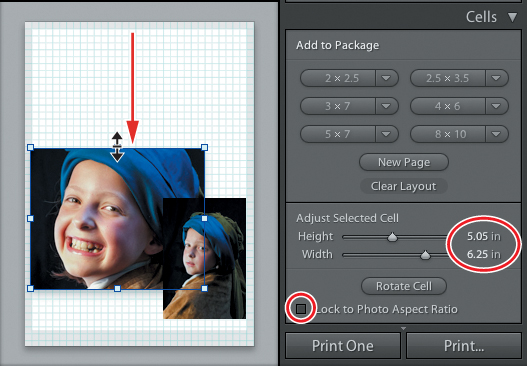
8. Hold down the Alt / Option key and drag the smaller image in the Print Editor view to produce a copy. Replace the photo in the copied cell by dragging the image Print-2.jpg from the Filmstrip.
9. Drag the three images in the Print Editor view to position them on the page as shown in the illustration below.

10. In the Image Settings panel, activate the Inner Stroke option. Move the Width slider to the left to set the width of the stroke to 0.5 pt. Leave the stroke color set to the default white; the white stroke borders will become visible when you set a background color in the next exercise.
Changing the page background color
To save on printer ink, you may prefer not to print a page with large areas of bold color or black in the background on your home printer, but when you’re ordering professional prints this can be a striking choice. For this exercise, you’ll set the background to reflect the blue in the girl’s headdress.
1. In the Rulers, Grid & Guides panel, disable Show Guides.
2. In the Page panel, click the checkbox to activate the Page Background Color option. Click the Page Background Color color swatch to open the Color Picker.
3. In the Color Picker, Click the R, G, and B percentages in turn and type values of 5%, 20%, and 35% respectively, and then click the Close button (x) or click outside the Color Picker to close it.

The new color appears in the Page Background Color color swatch and in the page preview in the Print Editor view.

Configuring the output settings
The final step before you’re ready to print your layout is to adjust the output settings in the Print Job panel.
1. Expand the Print Job panel in the right panel group.
From the Print To menu at the top of the Print Job panel you can choose to send the job directly to your printer or generate a JPEG file, which you can print later or send out for professional printing. The controls in the Print Job panel vary slightly depending on which option is selected in the Print To menu.
2. Choose Printer from the Print To menu at the top of the Print Job panel.

Activating the Draft Mode Printing option will disable the other options in the Print Job panel. Draft Mode Printing results in high speed output at a relatively low quality, which is an efficient option for printing contact sheets or for assessing your layout before you commit it to high quality photo paper. The 4 × 5 Contact Sheet and the 5 × 8 Contact Sheet templates are preset for Draft Mode Printing.
The terms “print resolution” and “printer resolution” have different meanings. “Print resolution” refers to the number of printed pixels per inch (ppi); “printer resolution” refers to the capability of the printer, called dots per inch (dpi). A printed pixel of a particular color is created by patterns of tiny dots of the few ink colors available.
The Print Resolution setting that is appropriate for your print job depends on the intended print size, the resolution of your image files, the capabilities of your printer, and the quality of your paper stock. The default print resolution is 240 ppi, which generally produces good results. As a rule of thumb, use a higher resolution for smaller, high quality prints (around 360 ppi for letter size). You can use a lower resolution setting for larger prints (around 180 ppi for 16″ × 20″) without compromising too much on quality.
3. The Print Resolution control has a range of 72 ppi to 1440 ppi. For this exercise, type 200 in the Print Resolution text box.

Images tend to look less sharp on paper than they do on screen. The Print Sharpening options can help to compensate for this by increasing the crispness of your printed output. You can choose between Low, Standard, and High Print Sharpening settings, and specify a Matte or Glossy Media Type. You won’t notice the effects of these settings on screen so it’s useful to experiment by printing at different settings to familiarize yourself with the results.
The purpose of the Sharpening feature in the Develop module is to compensate for blurriness in the original photo, while Print Sharpening improves the crispness of printed output on a particular paper type.
4. If it’s not already selected, choose Low from the Print Sharpening menu.

Using color management
Printing your digital images can be challenging: what you see on screen is not always what you get on paper. Lightroom is able to handle a very large color space but your printer may operate within a much more limited gamut.
In the Print Job panel, you can choose whether to have Lightroom handle color management or leave it up to your printer.

Color managed by your printer
The default Color Management setting in the Print Job panel is Managed By Printer. This can be the easiest option and, given the continuing improvement of printing technology, will generally produce satisfactory results. In the Print Setup / Print dialog box (File > Print Settings), you can specify the paper type, color handling, and other print settings. On Windows, click Properties in the Print Setup dialog box to access additional printer specific settings.
The options available in the Print Setup / Print dialog box may vary depending on your printer.

If you choose Managed By Printer, enable the ICM Method for Image Color Management (Windows) or activate the ColorSync option in the Color Management settings for the printer driver software (Mac OS) so that the correct profile is applied before printing. Depending on the printer driver software, you can usually find the color settings in the Print Document dialog box under Setup / Properties / Advanced (Windows), or in the menu below the Presets in the Print dialog box (Mac OS).
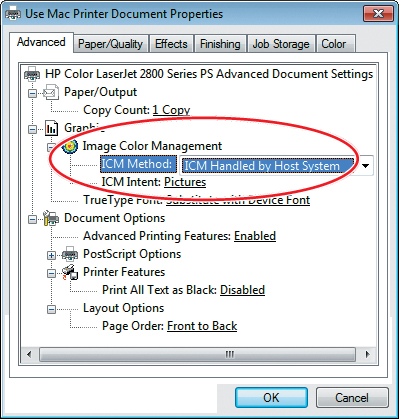
If you choose a custom printer color profile rather than Managed By Printer from the Profile menu in the Color Management panel, make sure color management is turned off in the printer driver software; otherwise, your photos will be color managed twice, and the colors might not print as you expect them to.
Color management controlled by Lightroom
Letting your printer manage color may be acceptable for general printing purposes but to achieve really high quality results it’s best to have Lightroom do it. If you choose this option you can specify a printing profile tailored to a particular type of paper or custom inks.
1. In the Print Job panel, choose Other from the Color Management Profile menu.
You can choose this option when the profile you want isn’t listed in the Profile menu. Lightroom searches your computer for custom printer profiles, which are usually installed by the software that came with your printer. If Lightroom is unable to locate any profiles, choose Managed By Printer and let the printer driver handle the color management.
2. Depending on your printer and paper stock, choose one or more printer profiles. In this illustration a profile for the Epson Stylus Pro R800 using glossy photo paper has been selected. Each profile you choose will be added to the Profile menu under Color Management in the Print Job panel for easy access next time you print.
The Include Display Profiles at the bottom of the Choose Profiles dialog box enables you to load color profiles for devices other than printers. This can be useful when you need to save your images to a different color space for use on the Internet.

Once you’ve chosen a printer profile from the Profile menu, the Rendering Intent options become available in the Print Job panel. The color space of an image is usually much larger than that within which most printers operate, which means that your printer may not be able to accurately reproduce the colors you see on screen. This may result in printing artifacts such as posterization or banding in color gradients as the printer attempts to deal with out-of-gamut colors. The Rendering Intent options help to minimize these problems. You can choose between two settings:
• Perceptual rendering aims at preserving the visual relationship between colors. The entire range of colors in the image will be re-mapped to fit within the color gamut your printer is able to reproduce. In this way, the relationships between all the colors are preserved but in the process even colors that were already in-gamut may be shifted as the out-of-gamut colors are moved into the printable range. This may mean that your printed image will be less vivid than it appeared on screen.
• Relative rendering prints all the in-gamut colors as they are and shifts out-of-gamut colors to the closest printable colors. Using this option means that more of the original color of the image is retained but some of the relationships between colors may be altered.
In most cases the differences between the two rendering methods are quite subtle. As a general rule, perceptual rendering is the best option for an image with many out-of-gamut colors and relative rendering works better for an image with only a few. However, unless you are very experienced it may be hard to tell which is which. The best policy is to do some testing with your printer. Print a very colorful, vivid photo at both settings and then do the same with a more muted image.
3. For the purposes of this exercise, choose Relative rendering.
Tweaking printed color manually
Printed results don’t always match the bright and saturated look of the colors you see on-screen in Lightroom—even when you’ve spent time setting up the color management for your print job.
The problem may be related to your printer, the inks or paper stock you’re using, or an incorrectly calibrated monitor; whatever the cause, you can make quick and easy adjustments with the Brightness and Contrast sliders in the Color Management pane of the Print Job panel.

The tone curve adjustments produced by the Print Adjustment sliders do not appear in the on-screen. preview. You may need to experiment a little to find the settings that work best for your printer.
Your Print Adjustment settings are specific to the combination of printer, paper, and ink that you’re using—they’ll stay in place as long as you’re working with the same output settings, and will be saved in the Lightroom catalog file with your custom template or saved print job.
Saving print settings as an output collection
Since you entered the Print module, you’ve been working with an unsaved print, as is indicated in the bar across the top of the Print Editor view.
Until you save your print job, the Print module works like a scratch pad. You can move to another module, or even close Lightroom, and find your settings unchanged when you return, but if you click a new layout template—or even the one you started with—in the Template Browser, the “scratch pad” will be cleared and all your work will be lost.
Converting your print job to a Saved Print not only preserves your layout and output settings, but also links your layout to the particular set of images for which it was designed. Your print job is saved as a special kind of collection—an output collection—with its own listing in the Collections panel. Clicking this listing will instantly retrieve the images you were working with, and reinstate all of your settings, no matter how many times the print layout scratch pad has been cleared.
Once you’ve saved your print job, any changes you make to the layout or output settings are auto-saved as you work.
Depending on the way you like to work, you can save your print job at any point in the process; you could create a Saved Print as soon as you enter the Print module with a selection of images or wait until your layout is polished.
A print output collection is different from a normal photo collection. A photo collection is merely a grouping of images to which you can apply any template or output settings you wish. An output collection links a photo collection (or a selection of images from that collection) to a particular template and specific output settings.
For the sake of clarity: an output collection also differs from a custom template. A template includes all your settings but no images; you can apply the template to any selection of images. An output collection links the template and all its settings to a particular selection of images.
1. Click the Create Saved Print button in the bar at the top of the Slideshow Editor view, or click the New Collection button (![]() ) in the header of the Collections panel and choose Create Print
) in the header of the Collections panel and choose Create Print
2. In the Create Print dialog box, type Portrait Prints as the name for your saved print job. In the Placement options, activate Top Level, and then click Create.

The Make New Virtual Copies option (Windows only) is useful if you wish to apply a particular treatment, such as a developing preset, to all the pictures in your print job, without affecting the photos in the source folder or collection.
Your saved print appears in the Collections panel, marked with a Saved Print icon (![]() ) to differentiate it from an image collection, which has a stacked photos icon. The image count shows that the new output collection contains three photos.
) to differentiate it from an image collection, which has a stacked photos icon. The image count shows that the new output collection contains three photos.

Adding more photos to a saved print job is easy: simply drag images to the gallery’s listing in the Collections panel. To open your layout in the Print module from the Library, click the white arrow that appears to the right of the image count when you move the pointer over your saved layout in the Collections panel.
The title bar above the Print Editor now displays the name of your saved print job, and no longer presents the Create Saved Print button.
Printing your job
1. Click the Print button at the bottom of the right panel group or choose File > Print.
2. Verify the settings in the Print dialog box and click OK / Print to print your page, or click Cancel to close the Print dialog box without printing.
Clicking the Print One button will send your print job to the printer queue without opening the Print dialog box. This is useful if you print repeatedly using the same settings and don’t need to confirm or change any settings in the Print dialog.
To achieve the best results when you print, calibrate and profile your monitor regularly, always verify that print settings are specified correctly, and use quality papers. However, there is no substitute for experience. Experiment with a variety of settings and options—and if at first you do succeed, consider yourself very lucky!
Congratulations! You’ve completed another Lightroom lesson. In this lesson you learned how to set up your own sophisticated print layouts.
In the process, you’ve explored the Print module and used the control panels to customize a print template—refining the layout and output settings and adding a background color, text, borders, and an identity plate to your printed page.
In the next chapter you’ll look at ways to publish and share your photos, but before you move on, take a few moments to refresh your new skills by reading through the review questions and answers on the following pages.
Review questions
1. How can you quickly preview the preset print templates, and how can you see how your photos will look in each layout?
2. What are the three print template layout styles, and how can you check which type of template you have chosen?
3. When you’re working with the Print Setup / Page Setup dialog box, why is it better to leave the Scale setting at 100%?
4. For what purposes is Draft Mode Printing appropriate?
5. What is the difference between a Saved Print collection, a photo collection, and a saved custom print template?
6. What is Soft Proofing?
Review answers
1. Move the pointer over the list of templates in the Template Browser to see a thumbnail preview of each layout displayed in the Preview panel. Select your images in the Filmstrip and choose a template from the list; the Print Editor view shows how your photos look in the new layout.
2. Single Image / Contact Sheet layouts can be used to print multiple photos at the same size on a single sheet. Based on an adjustable grid of image cells that are all the same size. They range from contact sheets with many cells to single-cell layouts such as the Fine Art Mat and Maximize Size templates. Picture Package layouts repeat a single image at a variety of sizes on the same page in cells that can be moved and rezized Custom Package layouts are not based on a grid; they enable you to print multiple images at any size on the same page, even arranged so that they overlap.
The Layout Style panel indicates whether a layout selected in the Template Browser is a Custom Package, Picture Package, or Single Image / Contact Sheet template.
3. Lightroom automatically scales your photos in the print layout template to fit the specified paper size. Changing the scale in the Print Setup / Page Setup dialog will result in the layout being scaled twice so your photos may not print at the desired size.
4. Draft Mode Printing results in high speed output at a relatively low quality, which is an efficient option for printing contact sheets or for assessing your layout before you commit it to high quality photo paper. The contact sheet templates are preset for Draft Mode Printing.
5. A photo collection is merely a virtual grouping of images to which you can apply any template or output settings you wish, whereas a Saved Print output collection links a selection of images to a particular template and specific layout and output settings. A saved print template preserves your customized layout and output settings but includes no images; you can apply the template to any selection of images. A Saved Print collection links the template and all its settings to a particular set of images.
6. Soft Proofing is a way to check on-screen how your photos will look when printed, or perhaps output for use on the Web. Lightroom uses color profiles to simulate the result of printing to specific printers with particular types of ink and paper—or of saving your images to a different color space as you might do with pictures intended for the Internet—enabling you to make the appropriate adjustments to your photos before exporting copies or committing to printing.




